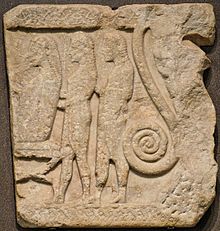Kabeiroi

Yunan mitolojisi, Kabeiroi (Cabiri, Cabeiri,[1] ya da Kabiri; Grekçe: Κάβειροι)
Kaynakça
- ^ Kabiri is the transliteration used in John Raffan's translation of Walter Burkert, Greek Religion (Harvard University Press, 1985), and in most academic discourse.
Kaynakça
- Burkert, Walter (1985). Greek Religion, Sect. VI.1.3 "The Kabeiroi and Samothrace",Harvard University Press. ISBN 0-674-36281-0.
- Ferguson, John (1970). The Religions of the Roman Empire (pp. 122–123). London: Thames and Hudson. ISBN 0-8014-9311-0.
- Hammond, N.G.L. & Scullard, H.H. (Eds.) (1970). The Oxford Classical Dictionary (p. 186). Oxford: Oxford University Press. ISBN 0-19-869117-3.
- Kerenyi, Karl (1951). Gods of the Greeks. Thames & Hudson. ISBN 0-500-27048-1.
- Bernard Evslin. Gods, Demigods and Demons: A Handbook of Greek Mythology. ISBN 978-1-84511-321-6.
- Michael B. Cosmopoulos. Greek Mysteries: The Archaeology and Ritual of Ancient Greek Secret Cults. ISBN 0-415-24873-6.
- The Odd Fellows Improved Manual, A.B Grosh 1871 p. 91
- Richard Noll, Mysteria: Jung and the Ancient Mysteries (unpublished page proofs, 1994) [1] 6 Kasım 2018 tarihinde Wayback Machine sitesinde arşivlendi.










